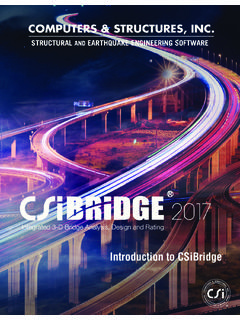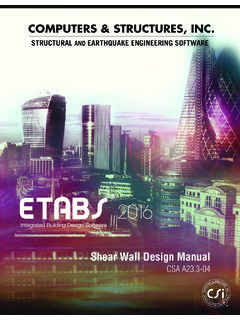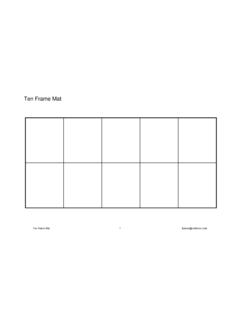Transcription of CSi Analysis Reference Manual
1 CSi Analysis Reference Manual CSI Analysis Reference Manual For SAP2000 , ETABS , SAFE . and CSiBridge . ISO# GEN062708M1 Berkeley, California, USA July 2016. COPYRIGHT. Copyright Computers & Structures, Inc., 1978-2016. All rights reserved. The CSI Logo , SAP2000 , ETABS , SAFE , CSiBridge , and SAPFire are TM. registered trademarks of Computers & Structures, Inc. Model-Alive and Watch & Learn are trademarks of Computers & Structures, Inc. Windows is a regis- TM. tered trademark of the Microsoft Corporation. Adobe and Acrobat are regis- tered trademarks of Adobe Systems Incorporated. The computer programs SAP2000 , ETABS , SAFE , and CSiBridge and all associated documentation are proprietary and copyrighted products. Worldwide rights of ownership rest with Computers & Structures, Inc. Unlicensed use of these programs or reproduction of documentation in any form, without prior written au- thorization from Computers & Structures, Inc.
2 , is explicitly prohibited. No part of this publication may be reproduced or distributed in any form or by any means, or stored in a database or retrieval system, without the prior explicit written permis- sion of the publisher. Further information and copies of this documentation may be obtained from: Computers & Structures, Inc. (for general information). (for technical support). DISCLAIMER. CONSIDERABLE TIME, EFFORT AND EXPENSE HAVE GONE. INTO THE DEVELOPMENT AND TESTING OF THIS SOFTWARE. HOWEVER, THE USER ACCEPTS AND UNDERSTANDS THAT. NO WARRANTY IS EXPRESSED OR IMPLIED BY THE DEVEL- OPERS OR THE DISTRIBUTORS ON THE ACCURACY OR THE. RELIABILITY OF THE PROGRAMS THESE PRODUCTS. THESE PRODUCTS ARE PRACTICAL AND POWERFUL TOOLS. FOR STRUCTURAL DESIGN. HOWEVER, THE USER MUST EX- PLICITLY UNDERSTAND THE BASIC ASSUMPTIONS OF THE. SOFTWARE MODELING, Analysis , AND DESIGN ALGO- RITHMS AND COMPENSATE FOR THE ASPECTS THAT ARE.
3 NOT ADDRESSED. THE INFORMATION PRODUCED BY THE SOFTWARE MUST BE. CHECKED BY A QUALIFIED AND EXPERIENCED ENGINEER. THE ENGINEER MUST INDEPENDENTLY VERIFY THE RE- SULTS AND TAKE PROFESSIONAL RESPONSIBILITY FOR THE. INFORMATION THAT IS USED. ACKNOWLEDGMENT. Thanks are due to all of the numerous structural engineers, who over the years have given valuable feedback that has contributed toward the en- hancement of this product to its current state. Special recognition is due Dr. Edward L. Wilson, Professor Emeritus, University of California at Berkeley, who was responsible for the con- ception and development of the original SAP series of programs and whose continued originality has produced many unique concepts that have been implemented in this version. Table of Contents Chapter I Introduction 1. Analysis Features .. 2. Structural Analysis and Design .. 3. About This Manual .. 3.
4 Topics.. 3. Typographical Conventions .. 4. Bold for Definitions .. 4. Bold for Variable Data.. 4. Italics for Mathematical Variables .. 4. Italics for Emphasis .. 5. Capitalized Names .. 5. Bibliographic References .. 5. Chapter II Objects and Elements 7. Objects .. 7. Objects and Elements .. 8. Groups .. 9. Chapter III Coordinate Systems 11. Overview .. 12. Global Coordinate System .. 12. Upward and Horizontal Directions .. 13. Defining Coordinate Systems .. 13. Vector Cross Product .. 13. Defining the Three Axes Using Two Vectors .. 14. i CSI Analysis Reference Manual Local Coordinate Systems.. 14. Alternate Coordinate Systems .. 16. Cylindrical and Spherical Coordinates .. 17. Chapter IV Joints and Degrees of Freedom 21. Overview .. 22. Modeling Considerations .. 23. Local Coordinate System .. 24. Advanced Local Coordinate System .. 24. Reference Vectors .. 25. Defining the Axis Reference Vector.
5 26. Defining the Plane Reference Vector.. 26. Determining the Local Axes from the Reference Vectors .. 27. Joint Coordinate Angles .. 28. Degrees of Freedom .. 30. Available and Unavailable Degrees of Freedom .. 31. Restrained Degrees of Freedom .. 32. Constrained Degrees of Freedom.. 32. Mixing Restraints and Constraints Not Recommended .. 32. Active Degrees of Freedom .. 33. Null Degrees of Freedom.. 34. Restraint Supports .. 34. Spring Supports .. 36. Nonlinear Supports .. 37. Distributed Supports .. 38. Joint Reactions .. 39. Base Reactions .. 39. Masses.. 40. Force Load .. 42. Ground Displacement Load .. 42. Restraint Displacements .. 43. Spring Displacements .. 44. Link/Support Displacements .. 45. Generalized Displacements .. 45. Degree of Freedom Output .. 46. Assembled Joint Mass Output.. 47. Displacement Output .. 47. Force Output .. 48. Element Joint Force Output.
6 48. ii Table of Contents Chapter V Constraints and Welds 49. Overview .. 50. Body Constraint .. 51. Joint Connectivity .. 51. Local Coordinate System .. 51. Constraint Equations .. 51. Plane Definition .. 52. Diaphragm Constraint .. 53. Joint Connectivity .. 53. Local Coordinate System .. 53. Constraint Equations .. 54. Plate Constraint .. 55. Joint Connectivity .. 55. Local Coordinate System .. 55. Constraint Equations .. 55. Axis Definition .. 56. Rod Constraint .. 56. Joint Connectivity .. 57. Local Coordinate System .. 57. Constraint Equations .. 57. Beam Constraint.. 58. Joint Connectivity .. 58. Local Coordinate System .. 59. Constraint Equations .. 59. Equal Constraint.. 59. Joint Connectivity .. 60. Local Coordinate System .. 60. Selected Degrees of Freedom .. 60. Constraint Equations .. 60. Local Constraint .. 61. Joint Connectivity .. 61. No Local Coordinate System.
7 62. Selected Degrees of Freedom .. 62. Constraint Equations .. 62. Welds .. 65. Automatic Master Joints.. 66. Stiffness, Mass, and Loads .. 66. Local Coordinate Systems .. 67. Constraint Output .. 67. iii CSI Analysis Reference Manual Chapter VI Material Properties 69. Overview .. 70. Local Coordinate System .. 70. Stresses and Strains .. 71. Isotropic Materials .. 73. Uniaxial Materials .. 74. Orthotropic Materials .. 75. Anisotropic Materials .. 75. Temperature-Dependent Properties .. 76. Element Material Temperature .. 77. Mass Density .. 77. Weight Density .. 78. Material Damping .. 78. Modal Damping .. 79. Viscous Proportional Damping.. 80. Hysteretic Proportional Damping .. 80. Nonlinear Material Behavior .. 80. Tension and Compression .. 81. Shear .. 81. Hysteresis.. 82. Application .. 83. Friction and Dilitational Angles .. 84. Hysteresis Models .. 85. Backbone Curve (Action vs.)
8 Deformation) .. 86. Cyclic Behavior.. 86. Elastic Hysteresis Model .. 88. Kinematic Hysteresis Model .. 88. Degrading Hysteresis Model .. 89. Takeda Hysteresis Model.. 93. Pivot Hysteresis Model .. 94. Concrete Hysteresis Model .. 95. BRB Hardening Hysteresis Model .. 97. Isotropic Hysteresis Model .. 99. Modified Darwin-Pecknold Concrete Model .. 100. Time-dependent Properties .. 101. Properties .. 101. Time-Integration Control .. 102. Design-Type .. 102. iv Table of Contents Chapter VII The Frame Element 105. Overview.. 106. Joint Connectivity .. 107. Insertion Points .. 107. Degrees of Freedom .. 108. Local Coordinate System .. 108. Longitudinal Axis 1 .. 109. Default Orientation .. 109. Coordinate Angle .. 110. Advanced Local Coordinate System .. 110. Reference Vector .. 112. Determining Transverse Axes 2 and 3 .. 113. Section Properties .. 114. Local Coordinate System.
9 115. Material Properties .. 115. Geometric Properties and Section Stiffnesses.. 116. Shape Type .. 116. Automatic Section Property Calculation .. 118. Section Property Database Files.. 118. Section-Designer Sections .. 118. Additional Mass and Weight .. 120. Non-prismatic Sections .. 120. Property Modifiers .. 123. Named Property Sets .. 124. Insertion Points .. 125. Local Axes .. 126. End Offsets.. 127. Clear Length.. 129. Rigid-end Factor .. 129. Effect upon Non-prismatic Elements .. 130. Effect upon Internal Force Output .. 130. Effect upon End Releases .. 130. End Releases .. 131. Unstable End Releases .. 132. Effect of End Offsets .. 132. Named Property Sets .. 132. Nonlinear Properties .. 133. Tension/Compression Limits .. 133. Plastic Hinge .. 134. Mass .. 134. Self-Weight Load .. 134. v CSI Analysis Reference Manual Gravity Load .. 135. Concentrated Span Load .. 135.
10 Distributed Span Load .. 137. Loaded Length .. 137. Load Intensity .. 137. Projected Loads .. 137. Temperature Load .. 140. Strain Load .. 141. Deformation Load .. 141. Target-Force Load .. 142. Internal Force Output .. 142. Effect of End Offsets .. 144. Stress Output .. 144. Chapter VIII Hinge Properties 147. Overview.. 147. Hinge Properties .. 149. Hinge Length .. 150. Plastic Deformation Curve .. 150. Scaling the Curve .. 151. Strength Loss .. 152. Types of P-M2-M3 Hinges .. 153. Isotropic P-M2-M3 Hinge.. 153. Parametric P-M2-M3 Hinge.. 156. Fiber P-M2-M3 Hinge .. 156. Hysteresis Models .. 157. Automatic, User-Defined, and Generated Properties .. 158. Automatic Hinge Properties .. 159. Analysis Modeling .. 161. Computational Considerations .. 162. Analysis Results .. 163. Chapter IX The Cable Element 165. Overview.. 166. Joint Connectivity .. 167. Undeformed Length .. 167.











